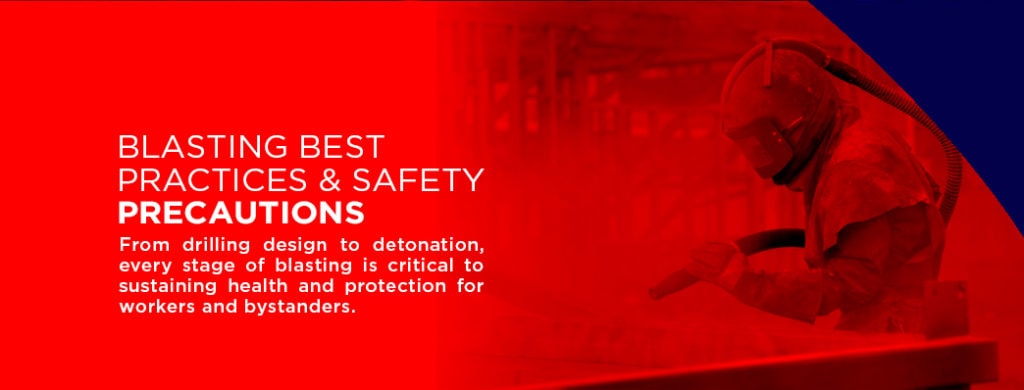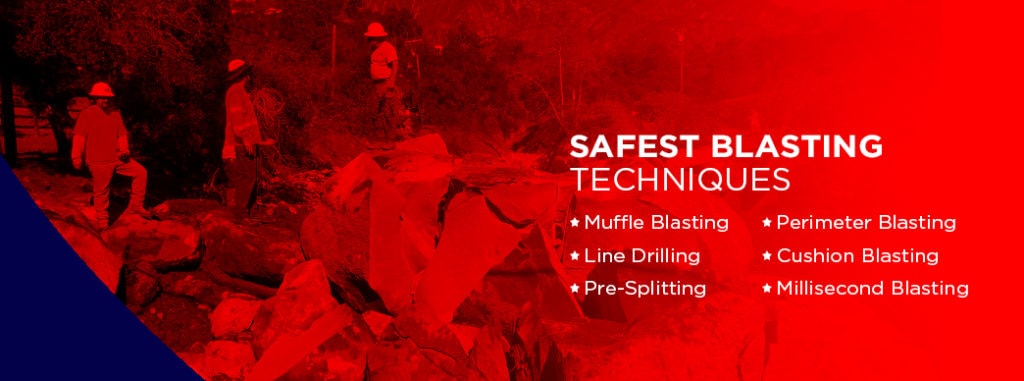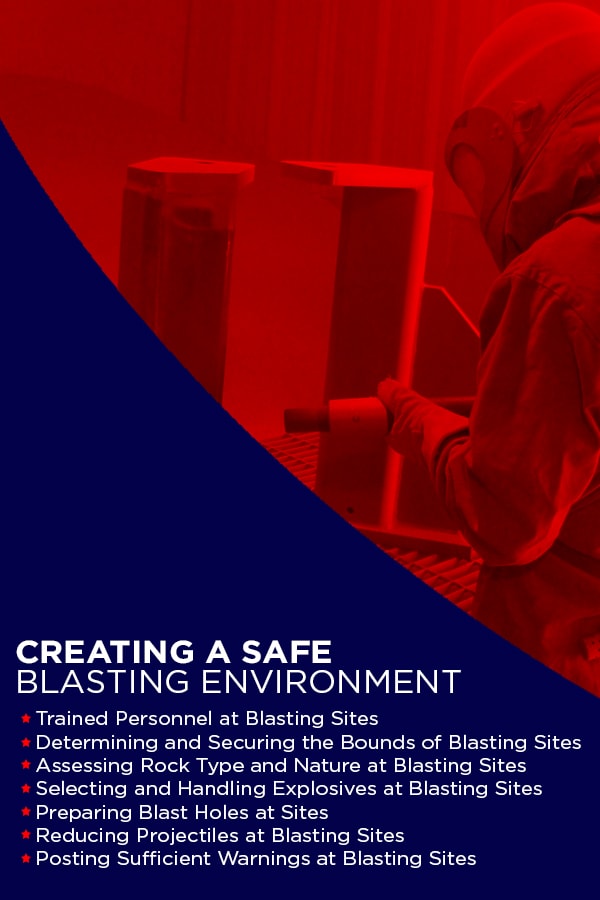
Channeling the power of explosives is an impressive ability, and industries like mining and construction rely on controlled blasts for many purposes. They guide the force of blasts in a productive way through deliberate planning and secure practices.
As crews move through their blasting safety checklists, they intentionally pursue safety and limit precarious scenarios. Such calculated steps have produced best practices for blasting across industries that everyone can benefit from following.
Blasting Best Practices & Safety Precautions

From drilling design to detonation, every stage of blasting is critical to sustaining health and protection for workers and bystanders. While researchers, engineers and professionals have generated insight into manipulating the site and substances, there are still uncertainties to watch out for.
Lowering the hazards around blasting zones is an ongoing goal of the industry, but accidents still happen. Fly-rock and insufficient blast area security are major causes of blasting-related injuries in surface mining.
VIEW OUR BLAST MITIGATION SOLUTIONS
Blasting safety precautions can propel the sectors forward and catalyze a sound environment. High standards initiate consistent results so workers can stay confident on the job.
Blasting Techniques and Process
Using explosives to open up an area, demolish structures or dispel rock is a complicated task because there are numerous risks. However, you can break the procedure into a few core parts. The basic steps of the blasting process involve:
- Evaluating the zone
- Placing the explosives
- Initiating the blast
- Clearing the area and reinforcing the site
1. Evaluation of Blast Zone
Whether in mining or construction, proper personnel first review the location and calculate the extent of the proposed blast. Considering the potential aftermath of the blast on the surrounding environment can control damages and prevent injuries.
Hazards like fumes and fly-rock can impact people and property, so the calculations should place all on-site individuals at a safe distance from the explosion. If the site is near commercial buildings or homes, the right setup is necessary to contain the repercussions.
Workers also monitor the premises to deter entry during the blasting event. Nearby vehicles and bystanders should be restricted to the outskirts to avoid losses.
2. Drilling and Placement of Explosives
After extensive evaluation of the site and the surrounding area, workers can drill and place the explosives for the blast. The explosives with a charge and detonator are strategically inserted in holes to break up compact material.
In mining and excavating, heavy machinery like drill rigs create the holes at a specific width and depth for optimum protection and power. The drill pattern is made up of burdens and spacing, and equipment, boundaries and the physical features of the location dictate the drill pattern.
You can carefully load the prepared explosives into the drilled holes. Depending on the type of explosives, some arrangements like priming charges, mixing agents or installing boosters could be essential to ensure firing capabilities.
Workers mechanically fill the remaining area in the blast holes with stemming, which is usually crushed stone, sand or concrete. This securely covers the explosives to increase fragmentation and enclose the substances.
3. Detonation
Once the site is ready, personnel can begin the initiation measures, which means everyone has to leave the blasting zone. Remote devices are generally used to detonate the explosives and break up the solid material, although manual initiation is possible.
According to the predetermined time schedule, the authorized workers coordinate the blast and announce the phases of the detonation. A time delay can implement a certain sequence for the explosives to discharge.
4. Site Clearing and Reinforcement
Identifying misfires and malfunctions is pivotal before approaching the blasting zone. Following a thorough inspection, activities for removing debris and chunks of rock or cement can start. Workers systematically dispose of the loose rock and wreckage to keep the area from unnecessary buildup and hazards.
Clearing the site allows workers to proceed with mining, demolition or construction operations. You can resume work on the site after the rubbish is gone and the waiting period is complete, but the surviving structure or cavities often need reinforcement.
Safest Blasting Techniques

As technology has influenced lives and professionals have gained experience, industries have developed and honed an array of blasting techniques. These combat certain risks, but they also can prioritize the well-being of workers and the continued good condition of property. These six blasting techniques are known as the safest to use in blasting.
1. Muffle Blasting
Scattered projectiles can strike workers or structures, and fly-rock is a serious consideration in explosion projects. Muffle blasting assembles protective gear on the blasting site to catch as much debris as possible.
Muffle blasting incorporates blast mats to interfere with the usual tossed shards of rock and particles. With blast mats, this strategy can deflect material flung from the explosion from populated areas. Blast mats are placed over the holes for maximum suppression.
This blasting technique is one of the safest approaches to blasts because it prevents hard material from escaping and hitting passersby or workers.
2. Line Drilling
With a series of holes in one line, line drilling can focus the impact of the blast on a particular area to minimize the shock and unpredictable shattering of the material. The row is tightly constructed so that the concentrated rock is weaker than normal, and the holes aren't packed with any explosives.
The uncharged line is created next to the intended excavation point, and it can bounce the force of explosives back toward the charged zone. Line drilling serves as a buffer for nearby structures during detonation, and it helps crews steer clear of overbreakage.
Fragmentation is confined to the vulnerable plane, so the surrounding ground doesn't absorb the blow from the explosion. This blasting technique can pinpoint the purpose of the project and reel in extra energy.
3. Pre-Splitting
Vibrations are a troublesome result from controlled explosions, but pre-splitting can lessen reverberations. For mining purposes, open cavities can undergo a preliminary round of blasting to establish a blockade prior to the principal blast.
Holes along the pre-splitting line have small distances, as with in line drilling, but pre-splitting loads the holes with minimal explosive contents. The slight blasts fracture the zone before the major explosion occurs, offering a more definite obstacle.
The waves from the main explosion can halt at this pre-split plane to keep the remaining area intact. This can be advantageous for workers because the residual material can stand strong without reinforcement.
4. Perimeter Blasting
For underground projects like tunnels, you can implement perimeter blasting techniques to preserve the material beneath. Perimeter blasting uses minor drilled columns to make a parallel contour that has more dimension than line drilling, although the techniques are similar.
Especially due to overhead material, perimeter blasting manages the depth of the blast. Secluding the damage to one section means less loose rock can threaten workers and supports aren't necessary.
You can improve your operations by centralizing the explosion project. This system shortens the process of cleanup and reinforcement so the crew can fix their full attention on the primary blast.
5. Cushion Blasting
Cushion blasting techniques are distinct because they save the secondary blasts until after the main explosion. As a final touch-up to the area, these smaller blasts around the edges smooth out the surface for a visual improvement.
This leaves the rock open to unseen fractures, which doesn't elevate security as much as the other blasting techniques. However, it does stabilize the surface to do away with follow-up work. Depending on the area, this final blasting can aid teams.
6. Millisecond Blasting
The detonation triggers the explosions in quick succession, but the minute delays in millisecond blasting can monitor the environmental impacts. You can use electronic devices to separate your blasts rather than executing the detonation in one explosion.
Spacing out the times, even slightly, can balance the breakage spots for enhanced fragmentation. Fly-rock can increase, while the shattering can divide the bulk of the rock without damaging the face of the stone.
Briefly spreading the explosions can diminish disturbances like vibrations. Strong air blasts that could influence the landscape can also decrease with millisecond blasting. Applying millisecond blasting effectively can input agreeable conditions.
Creating a Safe Blasting Environment

Throughout the course of blasting, there are plenty of dangers to consider. Promoting a secure setting for explosions can control the risks and lead to beneficial results. Supports and rigorous safety precautions in blasting operations can achieve better conditions for workers, allowing them to feel comfortable and adequately sheltered.
VIEW OUR BLASTING BEST PRACTICES MICROGRAPHIC
1. Trained Personnel at Blasting Sites
Informed and skilled workers are on the front lines for implementing safeguards. A range of specialists and operators can supervise the efforts on the blasting site and carry out protective regulations. Seamless teamwork is crucial in following the exact routine and confronting unexpected mishaps.
Blasting sites with a proficient supervisor or foreman can bring responsibility and assurance to an explosion area. A lead "blaster" collaborates with the foreman and presides over the blast, which instills additional defenses.
Auxiliary personnel, like a blasting crew, assists the chief workers in preserving protection by inspecting equipment and communicating important updates. Guards and blockers can keep people from entering the premises, so there's no exposure to released gases or projectiles.
The Bureau of Alcohol, Tobacco, Firearms and Explosives authorizes these kinds of workers to enact blasting activities, and company-specific training can further coach personnel to handle these procedures. With knowledgeable personnel on premises, the risks are minimized on the grounds.
2. Determining and Securing the Bounds of Blasting Sites
The size and vibration levels of the blast can be engineered to diminish negative outcomes. Configuring the magnitude takes research, and the terrain can alter the drilling layout.
Marking the boundaries with clear signs and impediments can cordon off the region. Berms or gathered material to designate the boundaries can prevent unauthorized people from entering the site.
3. Assessing Rock Type and Nature at Blasting Sites
Different categories of rock respond to explosive substances in unique ways, so separating the targeted material takes testing and a precise choice. The properties of the rock can make it fragment in distinct ways.
Knowing the density and strength of the material can help you conduct the blast and make accurate provisions. If the rock is thought to be weaker and a potent explosive is used, the blast could move beyond the radius, and rubble could hit nearby vehicles or buildings. The geological composition of the stone or concrete can lead you to the right tools to address the project.
4. Selecting and Handling Explosives at Blasting Sites
Currently, a variety of explosive products are available, and these should correspond with the nature and material of the blasting site. Prudent transportation and handling of these substances can avert early detonations and breaches in safety measures. Extreme chemical compounds that require caution include:
- Dynamite
- Nitroglycerin
- Picric acid
- Lead azide
- Fulminate of mercury
- Black powder
Water gels, emulsions or slurries are common blasting materials, and several crews combine these mixtures next to the blast sites using trucks. Another substance, ammonium nitrate and fuel oil (ANFO), frequently plays a role in explosions, too. Manipulating these volatile substances according to procedure can form a cohesive and safe environment.
5. Preparing Blast Holes at Sites
Accuracy in drilling holes can preserve your intentions for the scope of the explosion and manage effects like noise and trembling in the ground. Vague markings to label where to drill or positioning holes too close to each other can waylay operations.
The wrong angle and size can compromise the blast and set back the efforts of the crew. Quality planning and execution of drilling can bolster the energy in the correct direction.
6. Reducing Projectiles at Blasting Sites
Aside from stemming, blasting mats and shelters can fight the harmful effects of explosions. These can confine flying fragments, dust and emissions that might cause accidents.
Blast mats are made of rubber tire parts or steel cables to absorb the force, but rubber mats can catch fire, leading to greater danger for your job site. Durable steel cable mats can efficiently receive the impact from the explosions without the potential for fire, and the woven design allows gases to pass through. Without ventilation, the pressure can shoot the masses upward.
LEARN MORE ABOUT OUR BLAST MATS
While lead blasters move to an appropriate distance when the detonation occurs, they may be closer than the rest of the crew. The energy and byproducts from the blast can pose greater risks, but shelters can present a strong barrier for workers to wait out the explosions behind.
7. Posting Sufficient Warnings at Blasting Sites
Alerting on-site visitors and the community to the day and time of upcoming blasts can prevent detrimental incidents or inconvenient situations. Signs around the site can add visible warnings, and clear signals closer to the blasting time can remind people to maintain a distance.
Notification boards can keep workers in the loop and streamline communication between crew members. Backup communication channels can also serve as valuable support and provide comprehensive awareness.
Contact TM International, LLC, for Blast Mats
Furnishing your blasting sites with stable equipment and protective solutions is a key best practice. At TM International, LLC, we can assist you in finding efficient and affordable blasting supports.
Our blast mats can last you through many explosions, as they're recyclable and constructed from tough steel cables. With high-quality design, our blasting mats can withstand the impact of explosives and keep you safe. Contact us today to learn more about our blast mats and purchase them for your site.





